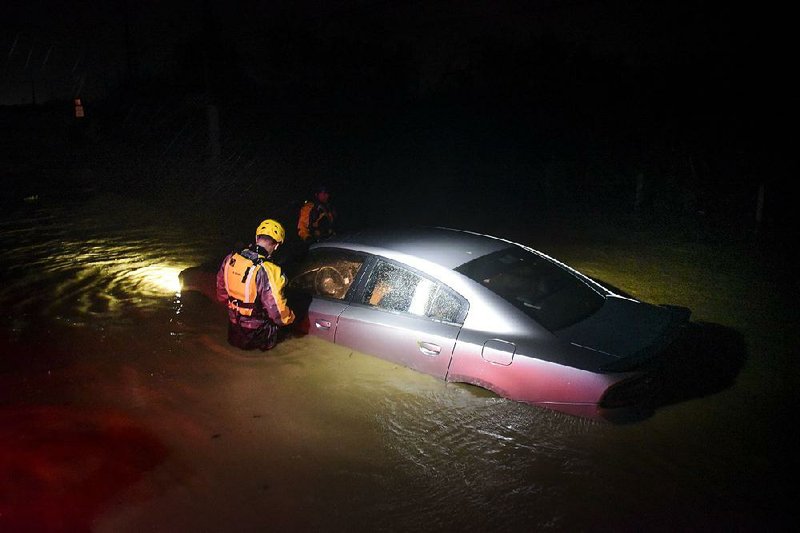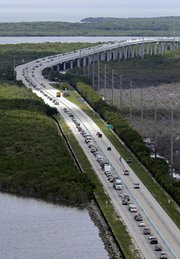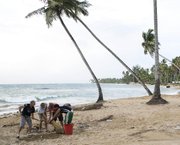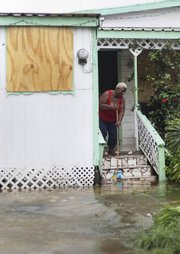SAN JUAN, Puerto Rico -- Hurricane Irma lashed Puerto Rico with heavy rain and powerful winds Wednesday night, leaving nearly 900,000 people without power as authorities struggled to get aid to small Caribbean islands already devastated by the storm.
Meanwhile, Florida rushed to prepare for a possible direct hit in the Miami area this weekend by the Category 5 storm and its 185 mph winds.
Nearly every building on the island of Barbuda was damaged when the eye of the storm passed over early Wednesday, and about 60 percent of the island's roughly 1,400 people were left homeless, Antigua and Barbuda Prime Minister Gaston Browne said.
"Either they were totally demolished, or they would have lost their roof," Browne said after returning to Antigua from a plane trip to the neighboring island. "It is just really a horrendous situation."
[HURRICANE TRACKER: Follow Irma’s projected path]
He said roads and telecommunications systems were destroyed and recovery will take months, if not years. A 2-year-old child was killed as a family tried to escape a damaged home during the storm, Browne said.
As the storm moved west, it tore up the small islands in its path.
On St. Martin, an island split between French and Dutch control, photos and video circulating on social media showed damage at the airport in Philipsburg and the coastal village of Marigot heavily flooded.
France sent emergency food and water rations there and to the French island of St. Bart's, where Irma ripped off roofs and knocked out all electricity. Dutch marines who flew to St. Martin and two other Dutch islands hammered by Irma reported extensive damage but no deaths or injuries.
By late Wednesday, the center of the storm was about 85 miles north-northwest of San Juan, Puerto Rico, and heading west-northwest at 16 mph.
More than half the island of Puerto Rico was without electricity and nearly 50,000 people were without water, the U.S. territory's emergency management agency said. Fourteen hospitals were using generators after losing electricity, and trees and light poles were strewn across roads.
The U.S. National Weather Service said Puerto Rico had not seen a hurricane of Irma's magnitude since Hurricane San Felipe in 1928, which killed 2,748 people in Guadeloupe, Puerto Rico and Florida.
Puerto Rico's public power company has cut back on staff and maintenance amid a decade-long economic crisis, and the agency's director warned that some areas could be without power from four to six months because the infrastructure has already deteriorated so badly.
State maintenance worker Juan Tosado said he was without power for three months after Hurricane Hugo killed dozens of people in Puerto Rico in 1989.
"I expect the same from this storm," he said. "It's going to be bad."
President Donald Trump this week approved an emergency declaration for the U.S. Virgin Islands and Puerto Rico. That means the Federal Emergency Management Agency and other agencies can remove debris and provide other services that will largely be paid for by the U.S. government.
Environmental Protection Agency officials said their biggest concerns were oil spills and disruptions to water supply systems.
"No matter what precautions we take, the coastal flooding will impact oil tanks," said Catherine McCabe, a regional administrator.
The U.S. National Hurricane Center said Irma's winds would fluctuate, but the storm would likely remain at Category 4 or 5 for the next day or two as it roars past Puerto Rico, the Dominican Republic, Haiti, Cuba, the Turks and Caicos, and parts of the Bahamas. Evacuations from high-risk areas were ordered throughout the path of the storm.
Tourist Pauline Jackson, a 59-year-old registered nurse from Tampa, Fla., puffed on her last cigarette as a San Juan hotel prepared to shutter its doors ahead of the storm.
"I'm in a hurricane here, and when I get home, I'll be in the same hurricane. It's crazy," she said.
She tried to leave ahead of the storm, but all flights were sold out, and she worried about her home in Tampa.
"When you're from Florida, you understand a Category 5 hurricane," said Jackson, who was scheduled to fly out Friday.
FLORIDA PREPARES
Tropical-storm-force winds are likely to arrive in Florida on Saturday, forecasters said, with the worst conditions occurring Sunday. The most extreme conditions are likely to occur near the storm center, but it is impossible this far ahead to pinpoint exactly where that will track, forecasters said.
Florida Gov. Rick Scott on Tuesday declared a state of emergency and said he planned to activate 7,000 National Guard soldiers by Friday. He warned Wednesday that Irma is "bigger, faster and stronger" than Hurricane Andrew, which pummeled south Florida 25 years ago and wiped out entire neighborhoods with its winds.
Trump also declared an emergency in Florida, and authorities in the Bahamas said they were evacuating six southern islands.
Experts worried that Irma could rake the entire Florida east coast from Miami to Jacksonville and then head into Savannah, Ga., and the Carolinas, striking highly populated areas.
As Irma drew closer, Georgia and South Carolina also declared states of emergency. North Carolina declared a state of emergency that will take effect this morning.
"This could easily be the most costly storm in U.S. history, which is saying a lot considering what just happened two weeks ago," said Brian McNoldy, a hurricane researcher at the University of Miami, referring to Hurricane Harvey.
On Aug. 25, Hurricane Harvey made landfall on the Texas coast as a Category 4 storm. It parked over the region, producing record rainfall that flooded thousands of homes and displaced tens of thousands of people. The storm has been blamed for at least 70 deaths.
The entire Florida Peninsula is only about 100 miles wide, which is small compared with the size of Irma. Tropical-storm-force winds now extend outward up to 185 miles from the storm center, and hurricane-force winds extend 50 miles in both directions, experts said.
An estimated 25,000 people or more fled the Florida Keys after all visitors were ordered to clear out, causing bumper-to-bumper traffic on the single highway that links the low-lying islands to the mainland.
But because of the uncertainty in any forecast this far ahead, state and local authorities in Miami and Fort Lauderdale held off for the time being on ordering any widespread evacuations in those areas.
The mayor of Miami-Dade County said Wednesday that people should be prepared to evacuate Miami Beach and most coastal areas as soon as Wednesday evening. He activated the emergency operation center and urged residents to have three days' worth of food and water.
Scott waived tolls on all Florida highways and told people that if they were thinking about leaving, they should "get out now." But in the same breath, he acknowledged that "it's hard to tell people where to go until we know exactly where it will go."
Scott also asked the governors of Alabama and Georgia to waive trucking regulations so gasoline tankers can get fuel into Florida quickly to ease shortages. Scott said he anticipated gas stations being restocked by this morning and urged people to take only what they need when fueling up.
Still haunted by Andrew, a sense of panic began to set in for some Floridians. Many hotels across the state have already been booked for the weekend by hurricane-wary residents. Most stores have run out of water, flashlights and other key supplies. Gas stations ran out of fuel.
Harvey also weighed heavily on people's minds.
"I think because of Texas, people are freaking out," said Yoseyn Ramos, 24, a Miami resident who said she was worried because she could not find gas anywhere.
But in Coral Gables, Jose Fonseca, 52, who works at the Mandarin Oriental on Brickell Key, said he had not done or bought anything to prepare for the storm.
"I think people are panicking because of the news from Texas day after day," he said. "I will buy some water." Then, he added, "And some beer, of course."
The State Department authorized the voluntary evacuation of U.S. diplomats and their families from the Dominican Republic, Haiti and Cuba, where the storm was expected to arrive by Friday.
Warm water is fuel for hurricanes, and Irma is moving over water that is 1.8 degrees warmer than normal. Four previous storms have had winds as strong as Irma's in the overall Atlantic region, but they were in the Caribbean Sea or the Gulf of Mexico, which usually have warmer waters. Hurricane Allen hit 190 mph in 1980, while 2005's Wilma, 1988's Gilbert and a 1935 Florida Keys storm all had 185 mph winds.
Bahamas Prime Minister Hubert Minnis said his government was evacuating six islands because authorities would not be able to help anyone caught in the "potentially catastrophic" wind, flooding and storm surge. People there were being flown to Nassau in what he called the largest storm evacuation in the country's history.
The northern parts of the Dominican Republic and Haiti could see 10 inches of rain, with as much as 20 inches in the southeast Bahamas, and Turks and Caicos.
The website cruisecritic.com said 28 cruises had been canceled, shortened or had their itineraries changed as a result of the hurricane.
Also Wednesday, Tropical Storm Katia formed in the Gulf of Mexico off Mexico's coast and rapidly became a hurricane. It had sustained winds of 75 mph by the afternoon, and the government of Mexico issued a hurricane watch for the coast of Veracruz state from Tuxpan to Laguna Verde.
Katia was about 185 miles north-northeast of the city of Veracruz and was expected to drift toward the coast today, the hurricane center said.
Another tropical storm farther east in the Atlantic became a hurricane Wednesday evening. Hurricane Jose posed no immediate threat to land, but meteorologists warned that the storm's path could change. Jose had winds of 75 mph and is strengthening.
Information for this article was contributed by Danica Coto, Anika Kentish, Jennifer Kay, Gary Fineout, Seth Borenstein, Michael Weissenstein, Ben Fox, Kelli Kennedy and Josh Replogle of The Associated Press; by Ivelisse Rivera and Lizette Alvarez of The New York Times; and by Jason Samenow and Brian McNoldy of The Washington Post.
RELATED ARTICLES
http://www.arkansas…">Arkansans in path of Hurricane Irmahttp://www.arkansas…">ASU, Miami offhttp://www.arkansas…">Trump, Democrats cut dealhttp://www.arkansas…">Disaster-relief sites teem, but cash talks
A Section on 09/07/2017



